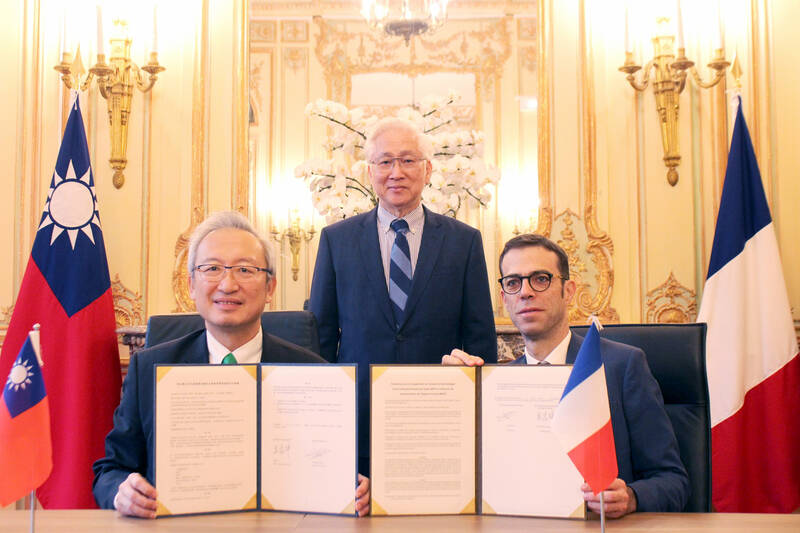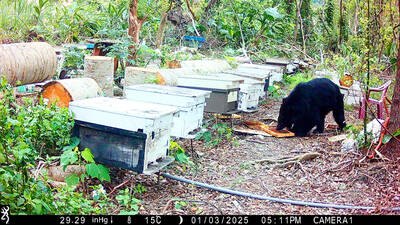Taiwan has signed science and technology cooperation agreements with 43 nations and three intergovernmental organizations, a National Science and Technology Council (NSTC) official said on Saturday.
Increasing global awareness of Taiwan’s key role in semiconductor manufacturing has opened doors for the council’s technology diplomacy, enabling the nation to ink state-to-state cooperative agreements, said Tom Yeh (葉至誠), director-general of the council’s Department of International Cooperation and Science Education.
While the council succeeded in signing memorandums of understanding with private entities, foreign capital had been wary of official collaboration for fear of angering Beijing, he said.

Photo courtesy of the National Science and Technology Council
Recent events, including a global chip shortage that gripped the auto industry, have led to a greater appreciation of Taiwan’s importance in the global semiconductor supply chain, he said, adding that a vast majority of countries seeking partnership with the nation wanted chips.
Most countries now understand that they must be as self-sufficient in technology as possible and avoid dependency on competitors or potential adversaries — factors that have bolstered Taiwan’s appeal as a trustworthy partner, Yeh said.
Taking advantage of the situation, Taiwan insisted on using only government-to-government documentation as a condition for cooperation — an approach that has largely succeeded due to the urgent need to secure chip supplies, he said.
Citing an example, Yeh said that German Chancellor Olaf Scholz recently stated that Germany simultaneously recognizes the “one China” policy while maintaining its sovereign right to freely choose diplomatic and technology partners for itself.
The council has signed 134 agreements with foreign states and organizations to date, he said.
Taiwan’s involvement in global science and technology programs includes research projects on semiconductors, lithium batteries, hydrogen energy, low-orbit satellites, auto chips and biomedicine, he said.
They also include its participation last year in the Horizon Europe Strategic Plan, APEC Ministerial Meeting on natural disaster prevention and response, and the inaugural Taiwan-US Science and Technology Cooperation Dialogue, Yeh said.
In addition, the National Research Council Canada sent a delegation to Taiwan to mark the 25th anniversary of bilateral scientific exchanges, and discuss earthquake engineering, artificial intelligence and other fields, he said.
Taiwan is a partner to Latvia and Lithuania’s research program on biomedicine and laser technology, the Philippines’ research program on earthquakes and volcanoes, and Australia and Germany’s hydrogen fuel production, transportation and storage research, he said.
The nation’s technology strategy is to leverage its advantages in semiconductors and information technology to support advances in artificial intelligence, cybersecurity, aviation and space, precision medicine, sustainable energy and sixth-generation Internet, Yeh said.
The US-China trade and technology war, Europe’s increasing mistrust of Beijing over its support of Russian aggression against Ukraine and the need to de-risk have led major European economic players to look to the Indo-Pacific region for their economic future.
These developments are an opportunity for Taiwan to amplify the advantages it can offer to Central and Eastern European nations as a prosperous and democratic economic partner, academics have said.
As part of its efforts to push science and technology diplomacy, the council also provides subsidies for international research exchanges.
Council statistics showed that the number of foreign researchers recruited to Taiwan over the past 10 years increased from 434 people in 2014 to 768 last year, with total subsidies last year reaching about NT$700 million (US$22.19 million).
The council has also launched programs to subsidize Taiwanese researchers’ studies abroad, such as the Overseas Project for Post Graduate Research program (千里馬計畫), the Partnership Program for Connection to the Top Labs in the World — Dragon Gate Program (龍門計畫) and the Subsidy for Short-Term Research Abroad for Technologists (補助科學與技術人員國外短期研究).
Last year, 318 Taiwanese researchers received about NT$300 million in subsidies through the programs.
“People” are the key to scientific research and development, Yeh said.
About three decades ago, Taiwan was a technology importer, with many Taiwanese leaving for studies in the US and returning to Taiwan to contribute to society what they have learned, he said.
Today Taiwan has become a technology exporter, he said.
However, he also expressed concern that with many young people choosing to study at local universities and given the high demand for talent in the local tech industry, these young people might “lack an international perspective.”
As such, the council still encourages them to explore abroad, while also inviting foreign experts to Taiwan for further exchanges, he said.
To expand the international experience of Taiwanese doctoral students, the council is offering subsidies for an additional 200 people who wish to study in Central and East Europe in select fields, Yeh said.
To stabilize domestic research capacity, the approval number and salaries for postdoctoral research fellows have been raised by 10 percent to 2,400 people, he said.
Yeh added that while Taiwan faces is facing a low birthrate problem, Southeast Asian countries enjoy a demographic dividend and many doctoral students and post-doctoral researchers are coming to Taiwan, with which they share a closer Asian cultural connection.

SHIPS, TRAINS AND AUTOMOBILES: The ministry has announced changes to varied transportation industries taking effect soon, with a number of effects for passengers Beginning next month, the post office is canceling signature upon delivery and written inquiry services for international registered small packets in accordance with the new policy of the Universal Postal Union, the Ministry of Transportation and Communications said yesterday. The new policy does not apply to packets that are to be delivered to China, the ministry said. Senders of international registered small packets would receive a NT$10 rebate on postage if the packets are sent from Jan. 1 to March 31, it added. The ministry said that three other policies are also scheduled to take effect next month. International cruise ship operators

NUMBERS IMBALANCE: More than 4 million Taiwanese have visited China this year, while only about half a million Chinese have visited here Beijing has yet to respond to Taiwan’s requests for negotiation over matters related to the recovery of cross-strait tourism, the Tourism Administration said yesterday. Taiwan’s tourism authority issued the statement after Chinese-language daily the China Times reported yesterday that the government’s policy of banning group tours to China does not stop Taiwanese from visiting the country. As of October, more than 4.2 million had traveled to China this year, exceeding last year. Beijing estimated the number of Taiwanese tourists in China could reach 4.5 million this year. By contrast, only 500,000 Chinese tourists are expected in Taiwan, the report said. The report

The Forestry and Nature Conservation Agency yesterday launched a gift box to market honey “certified by a Formosan black bear” in appreciation of a beekeeper’s amicable interaction with a honey-thieving bear. Beekeeper Chih Ming-chen (池明鎮) in January inspected his bee farm in Hualien County’s Jhuosi Township (卓溪) and found that more than 20 beehives had been destroyed and many hives were eaten, with bear droppings and paw prints near the destroyed hives, the agency said. Chih returned to the farm to move the remaining beehives away that evening when he encountered a Formosan black bear only 20m away, the agency said. The bear

Chinese embassy staffers attempted to interrupt an award ceremony of an international tea competition in France when the organizer introduced Taiwan and displayed the Republic of China flag, a Taiwanese tea farmer said in an interview published today. Hsieh Chung-lin (謝忠霖), chief executive of Juxin Tea Factory from Taichung's Lishan (梨山) area, on Dec. 2 attended the Teas of the World International Contest held at the Peruvian embassy in Paris. Hsieh was awarded a special prize for his Huagang Snow Source Tea by the nonprofit Agency for the Valorization of Agricultural Products (AVPA). During the ceremony, two Chinese embassy staffers in attendance